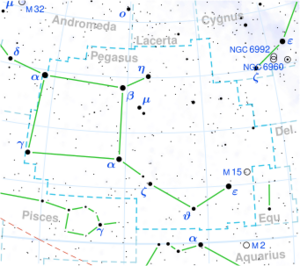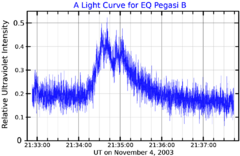Astronomy:EQ Pegasi
Coordinates: ![]() 23h 31m 52.1743s, +19° 56′ 14.1284″
23h 31m 52.1743s, +19° 56′ 14.1284″
Location of EQ Pegasi in the constellation Pegasus | |
| Observation data {{#ifeq:J2000.0|J2000.0 (ICRS)|Epoch J2000.0 Equinox J2000.0 (ICRS)| Epoch J2000.0 [[Astronomy:Equinox (celestial coordinates)|Equinox J2000.0}} | |
|---|---|
| Constellation | Pegasus |
| EQ Pegasi A | |
| Right ascension | 23h 31m 52.17385s[1] |
| Declination | +19° 56′ 14.1304″[1] |
| Apparent magnitude (V) | 10.38 (min)[2] |
| EQ Pegasi B | |
| Right ascension | 23h 31m 52.57534s[3] |
| Declination | +19° 56′ 14.0050″[3] |
| Apparent magnitude (V) | 12.58 (min)[2] |
| Characteristics | |
| EQ Pegasi A | |
| Evolutionary stage | red dwarf |
| Spectral type | M4Ve[2] |
| Variable type | Flare star[2] |
| EQ Pegasi B | |
| Evolutionary stage | red dwarf |
| Spectral type | M6Ve[2] |
| Variable type | Flare star[2] |
| Astrometry | |
| EQ Pegasi A | |
| Radial velocity (Rv) | −0.21±0.82[1] km/s |
| Proper motion (μ) | RA: 578.009(35)[1] mas/yr Dec.: −59.769(23)[1] mas/yr |
| Parallax (π) | 159.6634 ± 0.0341[1] mas |
| Distance | 20.428 ± 0.004 ly (6.263 ± 0.001 pc) |
| EQ Pegasi B | |
| Proper motion (μ) | RA: 552.349(55) mas/yr Dec.: 20.275(36) mas/yr |
| Parallax (π) | 159.9085 ± 0.0513[3] mas |
| Distance | 20.396 ± 0.007 ly (6.254 ± 0.002 pc) |
| Orbit[4] | |
| Period (P) | 83,664.63 ± 1.98 days (229.0613 ± 0.0054 a) |
| Semi-major axis (a) | 5.05797±0.00043" (31.635±0.033 astronomical unit|AU) |
| Eccentricity (e) | 0.108047±0.000053 |
| Inclination (i) | 130.065±0.010° |
| Longitude of the node (Ω) | 255.0919±0.0034° |
| Periastron epoch (T) | 2,401,891.34±1.19 |
| Argument of periastron (ω) (secondary) | 307.1416±0.0045° |
| Details | |
| A | |
| Mass | 0.43599±0.00092[4] M☉ |
| Radius | 0.35[5] R☉ |
| Luminosity | 0.019[6] L☉ |
| Temperature | 3,585[7] K |
| Rotation | 1.061 days[5] |
| B | |
| Mass | 0.16527±0.00025[4] M☉ |
| Radius | 0.25[5] R☉ |
| Luminosity | 0.008[6] L☉ |
| Temperature | 3,309[8] K |
| Rotation | 0.404 days[5] |
| Other designations | |
| EQ Peg A: TYC 1723-23-1, 2MASS J23315208+1956142[10] | |
| EQ Peg B: LFT 1800, LHS 3966, LTT 16920, NLTT 57136, TYC 1723-23-2, 2MASS J23315244+1956138[10] | |
| Database references | |
| SIMBAD | The system |
| A | |
| B | |
EQ Pegasi (also known as Gliese 896) is a nearby binary system of two red dwarfs. Both components are flare stars, with spectral types of M4Ve and M6Ve respectively, and a current separation between the components of 5.8 arcseconds. The system is at a distance of 20.4 light-years, and is 950 million years old.[11] The primary star is orbited by one known exoplanet.[4]
Discovery
EQ Pegasi was first noticed to be a binary star by Carl A. Wirtanen who in the course of a systematic survey of the McCormick Observatory photographic plates for M-type dwarfs, detected a companion about two magnitudes fainter at a separation of 3.5 arcseconds.[12]
Both components were also thought to be single-lined spectroscopic binaries, with faint companions that have not been resolved in orbits of a few years,[13][14] but this is no longer thought to be the case. A 2021 study of nearby stars states that "the spectroscopic binarity classification [...] is almost certainly due to activity".[15]
Planetary system
In 2022, a Jovian planet was discovered in orbit around the system's primary star via radio astrometry. Along with the planet around TVLM 513-46546, this is the first confirmed exoplanet discovered entirely using astrometry.[4]
| Companion (in order from star) |
Mass | Semimajor axis (AU) |
Orbital period (days) |
Eccentricity | Inclination | Radius |
|---|---|---|---|---|---|---|
| b | 2.26±0.57 MJ | 0.64282±0.00068 | 284.39±1.47 | 0.35±0.19 | 69.20±25.61° | — |
In culture
In 1998, it was the basis of a hoax, as a telecommunications company claimed it had discovered "alien" signals originating from the star.[16]
Gallery
A visual band light curve for EQ Pegasi A, adapted from Norton et al. (2007)[17]
An ultraviolet band light curve for a flare on EQ Pegasi B, adapted from Mathioudakis et al. (2006)[18]
References
- ↑ 1.0 1.1 1.2 1.3 1.4 Vallenari, A. et al. (2022). "Gaia Data Release 3. Summary of the content and survey properties". Astronomy & Astrophysics. doi:10.1051/0004-6361/202243940 Gaia DR3 record for this source at VizieR.
- ↑ 2.0 2.1 2.2 2.3 2.4 2.5 Samus, N. N. et al. (2009). "VizieR Online Data Catalog: General Catalogue of Variable Stars (Samus+ 2007-2013)". VizieR On-line Data Catalog: B/GCVS. Originally Published in: 2009yCat....102025S 1: B/gcvs. Bibcode: 2009yCat....102025S.
- ↑ 3.0 3.1 3.2 Vallenari, A. et al. (2022). "Gaia Data Release 3. Summary of the content and survey properties". Astronomy & Astrophysics. doi:10.1051/0004-6361/202243940 Gaia DR3 record for this source at VizieR.
- ↑ 4.0 4.1 4.2 4.3 4.4 4.5 Curiel, Salvador; Ortiz-León, Gisela N.; Mioduszewski, Amy J.; Sanchez-Bermudez, Joel (September 2022). "3D Orbital Architecture of a Dwarf Binary System and Its Planetary Companion". The Astronomical Journal 164 (3): 93. doi:10.3847/1538-3881/ac7c66. Bibcode: 2022AJ....164...93C.
- ↑ 5.0 5.1 5.2 5.3 Morin, J. et al. (October 2008). "Large-scale magnetic topologies of mid M dwarfs". Monthly Notices of the Royal Astronomical Society 390 (2): 567–581. doi:10.1111/j.1365-2966.2008.13809.x. Bibcode: 2008MNRAS.390..567M.
- ↑ 6.0 6.1 Morales, J. C.; Ribas, I.; Jordi, C. (2008). "The effect of activity on stellar temperatures and radii". Astronomy and Astrophysics 478 (2): 507. doi:10.1051/0004-6361:20078324. Bibcode: 2008A&A...478..507M.
- ↑ Brown, A. G. A. (August 2018). "Gaia Data Release 2: Summary of the contents and survey properties". Astronomy & Astrophysics 616: A1. doi:10.1051/0004-6361/201833051. Bibcode: 2018A&A...616A...1G. Gaia DR2 record for this source at VizieR.
- ↑ Brown, A. G. A. (August 2018). "Gaia Data Release 2: Summary of the contents and survey properties". Astronomy & Astrophysics 616: A1. doi:10.1051/0004-6361/201833051. Bibcode: 2018A&A...616A...1G. Gaia DR2 record for this source at VizieR.
- ↑ "BD+19 5116". SIMBAD. Centre de données astronomiques de Strasbourg. http://simbad.u-strasbg.fr/simbad/sim-basic?Ident=BD%2B19+5116.
- ↑ 10.0 10.1 "BD+19 5116A". SIMBAD. Centre de données astronomiques de Strasbourg. http://simbad.u-strasbg.fr/simbad/sim-basic?Ident=BD%2B19+5116A.
- ↑ Crosley, M. K.; Osten, R. A. (2018). "Constraining Stellar Coronal Mass Ejections through Multi-wavelength Analysis of the Active M Dwarf EQ Peg". The Astrophysical Journal 856 (1): 39. doi:10.3847/1538-4357/aaaec2. Bibcode: 2018ApJ...856...39C.
- ↑ Wirtanen, C. A. (1941). "A New dMe Double Star". Publications of the Astronomical Society of the Pacific 53 (316): 340. doi:10.1086/125371. Bibcode: 1941PASP...53..340W.
- ↑ Tokovinin, A.. "Multiple Star Catalog". http://www.ctio.noirlab.edu/~atokovin/stars/stars.php?cat=HIP&number=116132.
- ↑ Delfosse, X. et al. (April 1999). "New neighbours. I. 13 new companions to nearby M dwarfs". Astronomy and Astrophysics 344: 897-910. Bibcode: 1999A&A...344..897D.
- ↑ Reylé, Céline; Jardine, Kevin; Fouqué, Pascal; Caballero, Jose A.; Smart, Richard L.; Sozzetti, Alessandro (30 April 2021). "The 10 parsec sample in the Gaia era". Astronomy & Astrophysics 650: A201. doi:10.1051/0004-6361/202140985. Bibcode: 2021A&A...650A.201R. Data available at https://gruze.org/10pc/
- ↑ "BBC News | Sci/Tech | Alien hoax dismays scientists". http://news.bbc.co.uk/2/hi/science/nature/206845.stm.
- ↑ Norton, A. J.; Wheatley, P. J.; West, R. G.; Haswell, C. A.; Street, R. A.; Collier Cameron, A.; Christian, D. J.; Clarkson, W. I. et al. (May 2007). "New periodic variable stars coincident with ROSAT sources discovered using SuperWASP". Astronomy and Astrophysics 467 (2): 785–905. doi:10.1051/0004-6361:20077084. Bibcode: 2007A&A...467..785N. https://ui.adsabs.harvard.edu/abs/2007A&A...467..785N. Retrieved 11 February 2022.
- ↑ Mathioudakis, M.; Bloomfield, D. S.; Jess, D. B.; Dhillon, V. S.; Marsh, T. R. (September 2006). "The periodic variations of a white-light flare observed with ULTRACAM". Astronomy and Astrophysics 456 (1): 323–327. doi:10.1051/0004-6361:20054752. Bibcode: 2006A&A...456..323M. https://ui.adsabs.harvard.edu/abs/2006A&A...456..323M. Retrieved 12 February 2022.
 |




